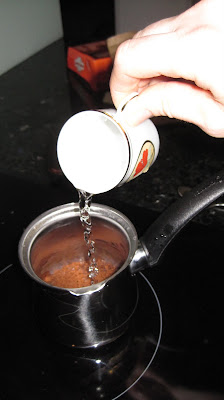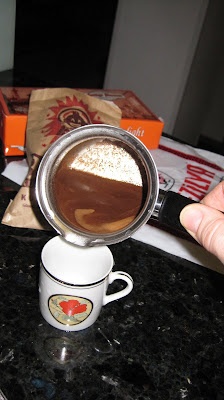
Istanbul's Galata Tower and Bridge.
If you get the chance to visit Istanbul, Turkey, take it! Bryan met a Turkish couple at a work conference in Tampere. They invited us to stay with them, and we started 2011 with a visit there. If Ferda and Emre's hosting style is typical, it's no wonder Turkish hospitality is famous. They generously rearranged their work schedules to make sure we got to see, taste and learn many things about Istanbul and Turkey. Thank you, Ferda and Emre!

Brooke and Analeise with Ferda.
Our five days there gave us a taste of the city - just enough to know that a month would not be enough time to see everything in Istanbul, let alone the many historical sites around other parts of Turkey. Istanbul straddles the Bosphorus Strait, making it the only city in the world to be on both the Asian and European continents. Its population is currently estimated at 15 million, with many people crossing the Bosphorus to get to and from work. The Bosphorus' two famous bridges and the many ferries that cross the Bosphorus, the Sea of Marmara, and the Golden Horn are quite crowded.
The city has played key roles in many empires (Greek, Roman, Ottoman to name the most influential), and that is evident in the architecture and the wonderful food. Napolean Bonaparte is quoted as saying, "If the earth was a single state, Istanbul would be its capital."
The country of Turkey officially began only in 1922 (taking control from the Ottoman Empire) and is secular despite the fact that it's population is over 95% Muslim. Beautiful mosques exist in almost every direction, and you'll hear the call to prayer five times each day.

The New Mosque (in Turkish,
Yeni Cami) was completed in 1663, after a stop-start construction process. It is in the Eminönü district, near the end of the Galata Bridge, which crosses the Golden Horn. This is still very much a working mosque, and although it is a popular tourist destination, I saw less tourists there than we saw at the Blue Mosque. The ceramic tiles inside are breath taking.

Tiles and calligraphy inside the New Mosque.

Bryan, Analeise and Brooke in front of the Blue Mosque. Only four of its minarets are visible. When it was finished in 1616, its six minarets were somewhat controversial, as the only other mosque with that many is at Mecca.
People dress in a variety of ways, including full cover for some women, all the way to completely western fashions on both men and women. In general, the style of dress we saw was more conservative than what I see in Finland (less piercings, far less visible tattoos, very few people with dreadlocks or wildly dyed hair).

Women on the left in full cover, and a woman on the right with a short skirt and high boots.
The food we ate was amazing and very fresh. I've read that eating seasonal foods has remained the custom in Istanbul, and in the winter, that means a lot of fish. We really enjoyed the kebabs (my favorite being beef with chopped pistachio, and Bryan and Brooke's being the lamb) and the desserts, especially the different types of baklava and freshly made Turkish Delight, which hands-down, is better than the packaged versions I've tasted in the U.S. As they are my favorite kind of nut, I was fortunate that pistachios were incorporated into many dishes, both savory and sweet.

This shows the mixed Kebab platter at Develi, a restaurant I'd highly recommend. With only Turkish food on the menu and exceptional service, this is a place worth finding. There are several Develis in Istanbul. We ate a harbor-side one on the Asian side of the city.

Turkish Delight!

Eating fish and french fries with Ferda and Emre. They and Bryan enjoyed a favorite Turkish Pilsner made by the company Efes. The girls and I drank fresh orange juice - yum!

Tea leaves are grown in Turkey, and tea is served regularly. Black tea is a common breakfast drink and is served even on short ferry crossings, in tulip shaped glass cups, even on the busy boats. We were told by our Turkish friends that only tourists drink the famous apple tea.


This photo shows Brooke with a cup of tea, after lunch at the beautiful Hidiv Kasri, an Ottoman Palace built in 1907. Lunch there is not cheap, but Analeise had the best shrimp dish of her life (shrimp and spinach in a tomato sauce, served in the cast iron pot in which it was cooked), and all of us thoroughly enjoyed our food, the elegant wood paneled dining room and the excellent service.

Tea cups for sale at the Spice Bazaar.
Bryan and I also loved the Turkish coffee and were very happy to have received a pot of our own from Ferda and Emre, complete with coffee from one of Istanbul's shops, Kuruyemiscisi, which is in the Kadikoy neighborhood of Istanbul. They also gave us a lesson on how to make the coffee (Directions will come soon. Look for a separate blog entry).

Turkish coffee.
Turkish Delight is commonly placed on the saucer when serving Turkish coffee. Also, many Turkish people drink water after a cup of coffee, and water is often automatically served with the coffee.
One night, college friends of mine from the International Club at Michigan Technological University took Bryan and me out for dinner. Sibel and Burak treated us to a meal completely made up of
Meze, which is a variety of small appetizer-like dishes, shared by all at the table. Similar to the concept of Spain's Tapas,
Meze are usually eaten at lunch or dinner time and are often accompanied by Turkey's anise flavored liquor,
Raki (roughly pronounced rock-ah).

A Meze platter. Eggplant dishes, cheese dishes, hummus, vegetable dishes - all delicious and served with flat bread.
It was great to see Sibel and Burak after so many years and to hear some of their perspectives on the city and region. Burak is from Istanbul, and Sibel moved there in 1991. She said the city's population has grown from about 8 million to 15 million in that time, and they both said that there have been major improvements to the water, sewage and road systems since then.

Burak, Sibel, Bryan and I along with the restaurant's Meze tray.
(Thanks, Sibel and Burak, for the great meal and conversation!)
During our stay, we were able to visit the Blue Mosque, Hagia Sofia, the Grand and Spice Bazaars, the famous marble gate of the University of Istanbul and the beautiful Asian coast of the Bosphorus Strait. There are so many sites worth visiting in Istanbul (Topkapi Palace, the Basilica Cistern, an abundance of beautiful mosques, the Archeological Museum, the Museum of Caligraphy, to name a few), it seems impossible to pay adequate attention to them all, even if you visit the city regularly.

The University of Istanbul's imposing marble gate.

The entrance we used during our visit to the Grand Bazaar. See photos of the bazaar below in the "Bonus Photos" section.

Interior of the Blue Mosque.

In the mosques we saw, the main prayer area is for men, with a smaller, separate area for women in the back. I found that walking into a mosque, and also hearing the call to prayer, created a calm stillness in me. When we walked into the Blue Mosque, with many other tourists, most people quieted right away, and I'm not sure if it's because people were praying inside or because of the calming and awe-inspiring affect of the architecture. Even the carpet in the Blue Mosque is beautiful.
Hagia Sofia, also known as Aya Sofia, was perhaps the most mesmerizing for me. Walking into the main room, you can't help but look up towards the very high dome.

Completed as a Christian basilica in 537, it took 11,000 workers (1,000 of them were master craftsmen) five years to complete, after a previous basilica on the site was burned to the ground during the Nikas revolt in 532.

These remnants are from the church that preceded Hagia Sofia, and they include the stairs at the left side of the photo, which were the stairs into the previous church.
I was surprised to hear that some of the columns inside were taken from a Greek temple in Ephesus. We were told that many pieces in the building were taken from other sites. Incorporating high-quality items such as the columns from Ephesus saved the builders time.

Hagia Sofia's interior. In the photos center are the columns originally from Ephesus.
Luckily, when the Ottomans, who were Muslim, conquered the city in 1453, they turned the church into a mosque, rather than destroying it. They plastered over Hagia Sofia's many mosaics. The building was turned into a museum in 1943, and most of the mosaics have been uncovered. Recovery work is still ongoing, currently focused on revealing the faces of the four, six-winged seraphims that decorate the ceiling. One seraphim's face was uncovered in the spring of 2010, and we were lucky to see it and the inside of Hagia Sofia without scaffolding, a first for something like seventeen years. Hagia Sofia's tiles vary in age, with the oldest being almost as old as the building. The seraphims are thought to be 700 years old and have been covered by layers of plaster for 160 years. Work will be done to remove the plaster from the remaining angels, which alas, means scaffolding will soon return to Hagia Sofia's interior.

The seraphim whose face was recently uncovered.
If you plan on visiting Istanbul, here are some things to consider:
- English is spoken by many in the heavily touristed areas (ex. the Grand Bazaar, Hagia Sofia, etc.), but not necessarily elsewhere. Familiarize yourself with some Turkish phrases before going.
- We went in winter. While that meant that it was chilly and rainy during our visit, it also meant that Hagia Sofia, the Grand Bazaar and the Blue Mosque were much, much less crowded than they are in the summer.
- Read some guide books and figure out in advance the key places you'd like to visit. My friend Sibel suggested paying a higher price to stay in a hotel near Sultanahmet, the area of town that houses the Grand Bazaar, Topkapi Palace, Hagia Sofia, the Blue Mosque and many other sites. This is good advice, in that travel can be quite slow around different areas of town, due to heavy traffic.
- Take some time to do at least a little reading about the history of the area - it is an amazing city, and some of its history will come to life as you visit its sites.
- Make sure to have Meze as part of a meal or as a meal while you're there.
Bonus Photos and a Video (at the bottom):

Analeise and me on a ferry ride across the Bosphorus (photo by Brooke).
The next several photos are from mosques:

The courtyard of the New Mosque.

Brooke and her ice cream with the Blue Mosque in the background.

A lonely-looking stray dog by the Blue Mosque's gate.

Blue Mosque, interior

Bryan took this photo of Analeise, Brooke and me in the Blue Mosque. It is requested that women cover their heads, and a donation is considered polite.

Next to the Blue Mosque, this is the tomb of Sultan Ahmed I.

One of the mosaics in the upper gallery of Hagia Sofia.

Photo taken from a window in the upstairs gallery of Hagia Sofia. The Blue Mosque is in the background.

Photos do not do justice to the immense interior of Hagia Sofia. A soccer field could fit inside it.

This shows you the back of one of the Ottoman Calligraphy pieces. They are huge and were constructed and painted on site. When modern-day Turkey became a country, Latin-based letters were adopted as the official alphabet. Now, it's usually only scholars who know how to read the old Ottoman style of writing.

In the 1500's, a Sultan named Suleiman the Magnificent brought two huge candles (yes, those are really old and really big candles in the photo) and had them placed on either side of the mihrab, which indicates the direction of Mecca, for prayers. Analeise took this photo.

Many feet have worn down this step over the centuries.

There was for me, a feeling of mystery inside Hagia Sofia.
The Spice Bazaar!

Meats, cheeses and honey.



From here, we bought dried and candied raspberries and lime and pineapple slices.

The Grand Bazaar!


While they were beautiful, we were told by a vendor that despite what anyone told us, the glaze used on these ceramics contains lead, making these bowls for decorative purposes only. That was disappointing, but it was still fun to look.
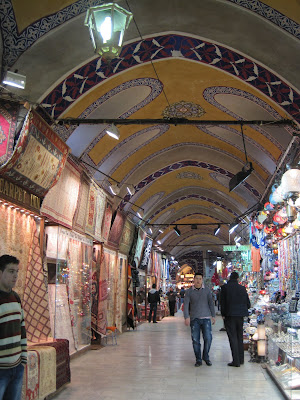
The Grand Bazaar's construction began almost immediately with the Ottoman 's rule of the city. Mehmet II, demanded that an area be set up for selling items, with the proceeds being used to refurbish Hagia Sofia and convert it into a mosque. The structure was soon covered with tiled and vaulted ceilings, and then areas were added over time. So, at over 550 years-old, this is the oldest indoor mall on the planet.

There are many vendors selling outside the Grand Bazaar.
Here are two shots of Brooke having fun with the pigeons near Istanbul University's famous gate:



This photo shows the famous Galata district. The tower dates back to 1348.

The main train station on the Asian side, Haydarpaşa, was built in 1908. Still in use, it is being restored after a horrible fire in the fall of 2010.

Yellow mini-vans such as these are a common type of transport around the city. You'll see areas where they converge, and they basically go along certain routes, with passengers paying a set fee and able to ask to be let off anywhere along the route. They're kind of a marriage of a bus and a taxi.
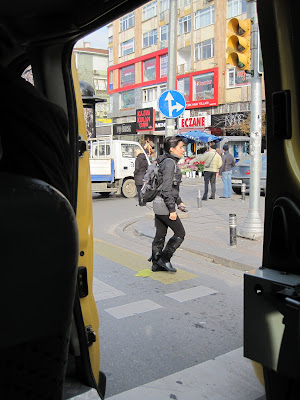
A street shot taken from one of the above mini-vans.

We saw hundreds of exercise areas such as this in the city's numerous parks. This one is near the Princes' Islands, alongside the Sea of Marmara.

Our shadows in Istanbul - Brooke and me.

One of the Princes' Islands is visible in the background.

The girls by the Sea of Marmara.


The Princes' Islands.

Many homes take advantage of the views of the Sea of Marmara.

An orange, fresh from Ferda and Emre's tree!

The upstairs kitchen of Ferda and Emre's lovely house near the Sea of Marmara.

Night Life!

A mall in the Maltepe area of Istanbul. Turkish clothes and textiles are known for being high quality and are available at lower prices than similar clothes in other parts of Europe.

There were countless dress shops in Istanbul, with wedding dress prominently featured. Even with a population of 15 million, I really wondered how so many of them could stay in business.

A street shot in the Sultanahmet area, near Hagia Sofia and the Blue Mosque.

Near the Sultanahmet area.

Flowers for sale!
Food Shots:

We had fresh orange juice most mornings at Emre and Ferda's. Brooke really enjoyed helping to make it one of the mornings.

Ferda and Emre's table, set for breakfast. Ferda bought some cookies from a bakery, with the girls in mind. My favorite one resembled shortbread, but was green because of the pistachios inside. Another one contained cherries. Delicious!

Beef kebab, rice and bread.

Bryan near the grill area of a restaurant.

Emre, Ferda and us at Develi, one of my favorite restaurants ever.
The next five photos were taken from the Asian side of the Bosphorus Strait:

Thanks, Emre, for taking this photo of us with the Bosphorus Bridge in the background.

There are areas where homes were built right on the edge of the Bosphorus. Some of the homes pictured here were built for nobility as early as the 1700's. On the right hand side of the photo, you can also see Roman-built fortification and wall that held back invaders for hundreds of years. in the 1400's, the Ottomans built a larger fort/castle and walls on the other side of the Bosphorus.


This hotel is only available to Turkey's teachers and those traveling with them. It is reasonably priced and positioned right along the Bosphorus, on the Asian side. So, when a teacher has to attend a conference in Istanbul or wants to visit the city, they have a beautiful, affordable place to stay - a nice perk and show of respect for the nation's teachers!
The next few photos are from the Ottoman palace called Hidiv Kasri:

Designed by Italian architect, Delfo Seminati, the palace was completed in 1907.


This is the only Ottoman Palace that houses a restaurant.

There were thousands of crows, all with a lot to say, in the trees surrounding Hidiv Kasri. Emre told us that there is a saying that when crows get together in these numbers, snow is coming. Luckily for us, the saying did not prove true during our stay!

Surrounding the palace is a public park with a walking trail. Along the trail, there is exercise equipment, a common site at Istanbul's parks.


Brooke, outside Hidiv Kasri. It was chilly in Istanbul, but we were happy for a break from Finland's snow, and there were still flowers in bloom! This blossom is one Analeise found on the ground near one of the palaces' fountains.
Various shots:

Beautiful marble and other stone is used all over the city. Emre and Ferda's driveway is even decorated with it.

We saw a few of these winding, striped streets. I love how they look.

You'll see stray dogs and cats, almost everywhere. Many of the dogs have plastic tags in an ear to show that the local government has had them neutered. I saw many of the dogs being pet by passersby. I don't know what the dogs eat, but Brooke pointed out that the cats probably help keep the rat and mouse populations in check.


This is one of two cats we saw at Hagia Sofia. The other one, named Gli, has lived at the museum for six years and came to fame when it was pet by President Obama in April 2009.

The Maiden Tower looks lonely in this photo, but it has many stories to tell. With a tower at this site since 408 BC, it has witnessed all the empires in Istanbul's known lineage. Legend has it that a Sultan's daughter was housed at this castle long ago, because it had been fortold that she'd be killed by a snake. Even on this isolated spot, the prophecy came true when a poisonous snake hitched a ride to the island in a basket of food. The tower is not tall, but it offers great views of the city, which impressed us greatly, even on a foggy day. Below is a video taken from the tower, taken during a call to prayer.
 There were video and board games for the kids, and we all enjoyed yummy food, fortune telling and at midnight, fireworks outside.
There were video and board games for the kids, and we all enjoyed yummy food, fortune telling and at midnight, fireworks outside.
 Analeise gets ready to try the tradition.
Analeise gets ready to try the tradition. Tero and Brooke watch Seppo melt a horseshoe as Silja and Elli wait nearby.
Tero and Brooke watch Seppo melt a horseshoe as Silja and Elli wait nearby. Maikki melts her horseshoe, with mom, Hanna-Mari nearby. The molten metal is dropped into a bucket of cold water, and the shadow of the resultant shape is studied for hints of what is to come during the next year.
Maikki melts her horseshoe, with mom, Hanna-Mari nearby. The molten metal is dropped into a bucket of cold water, and the shadow of the resultant shape is studied for hints of what is to come during the next year.

 Thank you to Taina and Seppo for hosting! We were very happy to spend the and to the Kuusijärvi and Välisalo families for helping our Finnish New Years be memorable.
Thank you to Taina and Seppo for hosting! We were very happy to spend the and to the Kuusijärvi and Välisalo families for helping our Finnish New Years be memorable. Taina made sure we were well fed throughout the night - tasty Finnish cheese!
Taina made sure we were well fed throughout the night - tasty Finnish cheese!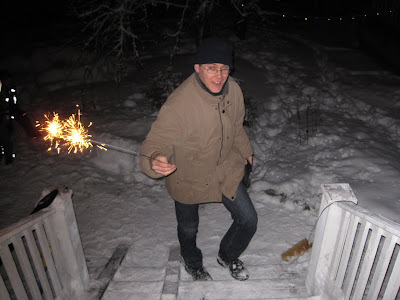 Seppo, Fortune Teller Extraordinaire.
Seppo, Fortune Teller Extraordinaire.













